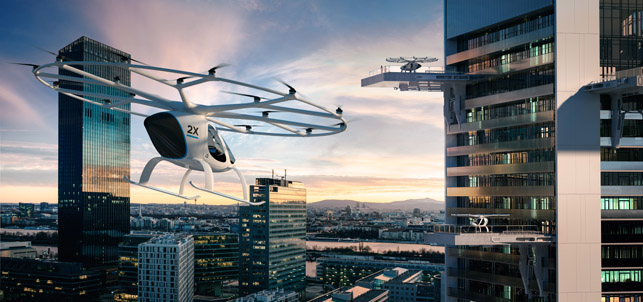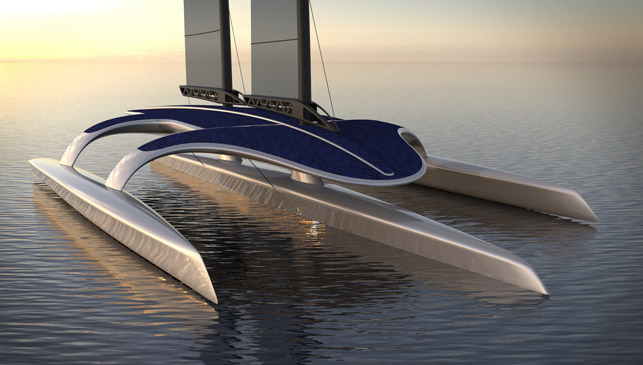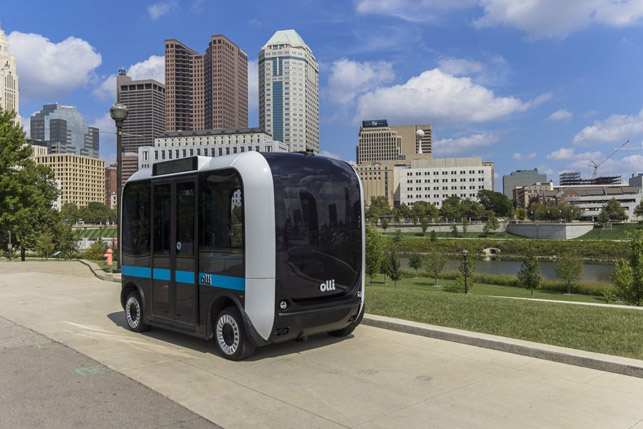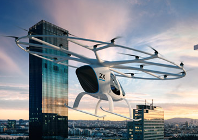
With the vision of helping modern cities resolve their increasing mobility issues, the Volocopter 2X can fly completely autonomously operating as an air taxi for short trips to airports or business parks
High flyers
We can all imagine the scenario – standing in your hotel room on the 27th floor looking down at the traffic crawling below feeling anxious about getting to the airport on time for your flight home.
So you decide to hail a taxi using an app on your phone but this isn’t an ordinary taxi, it’s a personalised, autonomous air taxi. You meet it on the hotel roof and it transports you a short distance above the city to the airport.
This is not a scene from ‘The Jetsons’. If German aviation start-up Volocopter has anything to do with it, it could be a reality in just a few years.
It has developed a two-seater, fully electric multicopter that features 18 rotors to help resolve mobility issues in modern cities. The vision is that these autonomous Volocopters will take off every minute from hubs that connect airports and business parks with city centres to relieve congestion-prone areas.
“I have been interested in flying cars and following their development for a while. When I saw the Volocopter I got it: The ‘flying car’ has no wheels! In the coming years we can expect a revolution in manned aviation and we at Volocopter will significantly contribute to shaping it,” says Lukasz Gadowski, chairman and serial entrepreneur who joined the company last year as an investor along with a few other big name investors including auto company Daimler.
Founded in 2011, Volocopter is designing, developing and building its helicopter in Bruchsal, Germany. From the initial idea to the software and electronic components through to the latest version, the Volocopter 2X, it’s all done in-house.
“Although the Volocopter might resemble a helicopter, it really is a flying super computer creating a pleasant and safe ride,” explains Florian Reuter, CEO. He goes on to explain that the company has traded in the entire mechanical complexity of today’s helicopters for electronic complexity, which he claims is more lightweight, powerful and cheaper.
Its 18 rotors are powered by nine independent battery systems that power two batteries each. Intel Flight Control Technology analyses environmental data with highly redundant sensors and is able to compensate for certain flight malfunctions.
The technology also helps stabilise the vehicle if windy or there’s turbulence.
In 2016, Volocopter was granted provisional licensing by the German aviation authority and in 2017 it entered into an agreement with the Roads and Transport Authority in Dubai following a successful test flight above Dubai in September 2017.
Volocopter co-founder Alexander Zosel says, “We have now publicly proven the safety, compliance and relevance of Volocopter in the urban environment in one of the most forward-thinking cities of the world.
Others will follow soon. A new era of public transport has begun.”

The Mayflower Autonomous Ship (MAS) will participate in the Mayflower 400 Commemorations in 2020
Ship shape
In 1620 The Mayflower famously transported 102 English Puritans (or pilgrims as they’ve become known) from Plymouth, UK, to the New World (or the USA as it’s become known).
Now, a new ‘Mayflower’ is currently in development to celebrate the 400th anniversary of this voyage across the Atlantic. However, it will have no passengers or crew onboard as it will be making the crossing in 2020 completely autonomously and will be conducting scientific research as it does so.
The team behind the Mayflower Autonomous Ship (MAS) compromises MSubs, an autonomous craft specialist, ProMare, a charitable research foundation, and Plymouth University. Design consultancy Shuttleworth Design is designing the vessel with Qinetiq providing technical expertise.
Detailed development of the design is underway and Shuttleworth Design is preparing scale models for testing.
“Working within the limitations of renewable energy sources has given a clear direction to the developing form of the vessel. The solar cell area required for effective motoring is too large for efficient sailing. To overcome this we are developing a folding wing system to increase the solar cell area by 40 per cent, explains John Shuttleworth.

#AccessibleOlli is an electric, autonomous bus from Local Motors that aims to make transportation accessible for all
Autonomous for all
In 2016, automotive manufacturer Local Motors unveiled an autonomous, electric-powered, partially 3D printed bus called Olli. Holding up to ten people, it was the result of a co-creation challenge.
During last year’s Consumer Electronics Show (CES), the company revealed that it will be working with IBM (Olli uses IBM Watson technology, along with IBM IoT for Automotive) to create an accessible version of Olli.
A year later, at this year’s CES in January, it unveiled #AccessibleOlli – a 90 per cent 3D printed version that is enhanced with an array of technologies to provide solutions for those with impairments and disabilities.
The crowd-sourced design is a result of numerous workshops, hackathons and challenges with a broad range of partners.
“What we noticed during the research and co-creation experience is that no one is talking about how people will interact with a vehicle that has no driver, and how this greatly impacts those with disabilities or impairments who rely on the ‘driver’ to assist them,” says Brittany Stotler, vice president marketing, Local Motors.
One of the features within #AccessibleOlli is that it can direct anyone to empty seats using machine vision to identify open spots and audio cues to direct the passenger.

A look at three modes of transport that are operator free
Default






